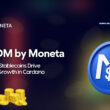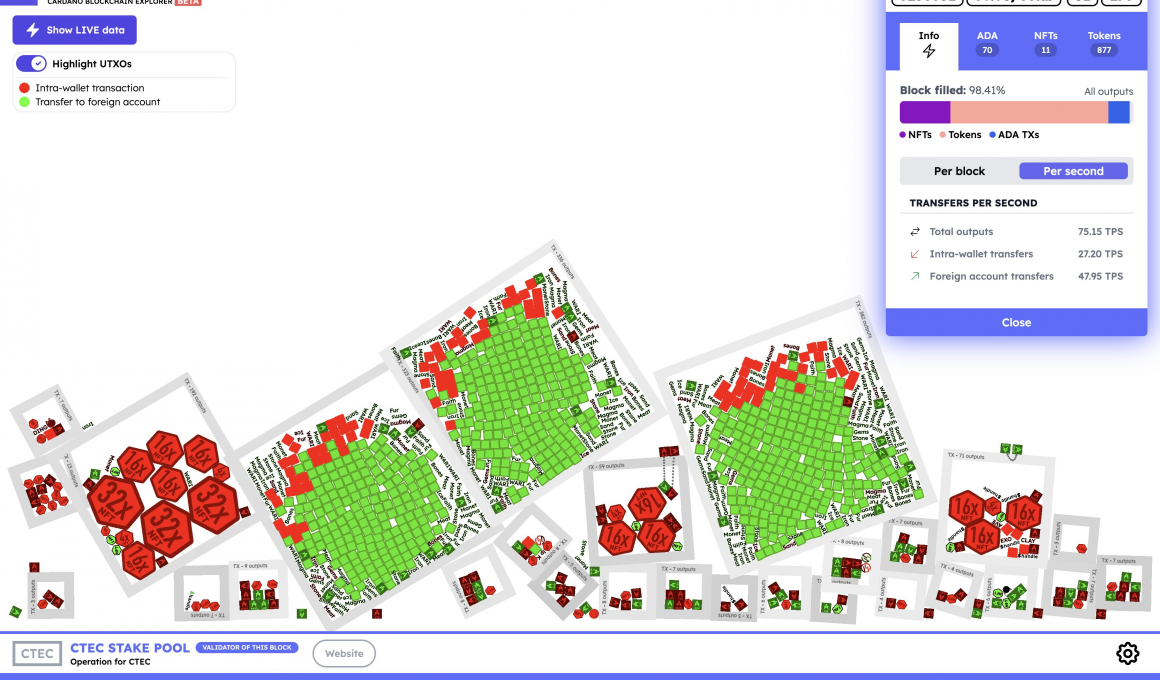A New Look at Cardano
eUTxO.org is a marvelous visual resource for Cardano. It strikes a rare balance between educational tool and art-exhibit. The beauty lies in the distillation of the network’s underlying mechanisms, which makes it possible for the viewer to understand what is inside blocks as they are added to the chain, even if they’re not subject matter experts.
An aesthetically pleasing real-time visualization of block production on Cardano is something I didn’t know I needed until I experienced eUTxO.org. Fans of Cardano and students of blockchain will find an engaging and rewarding way to become familiar with the fundamentals of how the protocol operates.
I was lucky enough to get a brief interview with Peter Oravec, the creator of eUTxO.org, and he provided some great insights.
This project came about accidentally as an attempt to visualize the contents of blocks, and I never expected it to be received so positively. That’s why version 2 was created and further development is ongoing. But the answer is simple, as the saying goes “it’s better to see once than to hear a hundred times” and this kind of visualization can help understand what is actually happening inside the blocks. Without visualization, you only see hashes, which don’t tell you much. Also, watching falling blocks can sometimes have a calming effect, and that’s why people like it.
Peter Oravec
When we observe eUTxO.org we’re taking in a lot of data, including:
Block Height – This is position of the block being visualized relative to the rest of the Cardano blockchain. Block Size – The maximum block size on Cardano is 88kb. However, blocks don’t have to be full to be produced and added to the chain. A Cardano block can contain muliple Transactions (Txs), which may hold a blend of NFTs, Tokens, and ADA. UTxOs – (Unspent Transaction Outputs) In a recent AdaPulse article, Sooraj described the UTxO ledger model as follows: “Inidividual transactions consist of lists of ‘inputs’ and ‘outputs’ and the sum of the values consumed by a transaction’s inputs must equal the sum of the values provided by its outputs. The output of every transaction can be utilized as an input in a future transaction.” Transfers per Block – Shows the total outputs in the block. This number is the sum of intra-wallet transfers and foreign account transfers. Transfers per Second – Shows the performance of the chain from a different perspective.
There are three types of visualizations on eutxo.org:
• Single element – a transaction with only one type of asset
• Chained element – a transaction with just two assets, mostly TOKEN + ADA fee
• Box with assets – a transaction with more than three assets inside.
Peter Oravec
Discover Interesting Txs & Blocks
eUTxO.org has a great page on the website where you can see stand-out performance organized into several unique categories:
Most unique recipients in one Tx (total number of unique recipients of single transaction). This block contained 247 Foreign Account Transfers in a single Tx and serves as a great example of how the ‘Highlight UTxOs’ feature works. The screenshot below shows the default view:

Highlight UTxOs – Intra-Wallet Transactions shaded red and Foreign Account Transfers shaded green. The image below shows the same block, but with ‘Highlight UTxOs’ activated:

Most assets to foreign accounts in one block (total number of assets transferred to foreign accounts in one block). This block is LOADED with Tokens! Here’s how the Tx count breaks down (ADA: 70, NFTs: 11, Tokens: 877) in the photo below:

Most TPS to foreign accounts (total number of assets transferred to foreign accounts calculated to account model TPS). The most transfers per second also occurred in the block above [Epoch 387, Block Height 8258951].
Most native TXs (total number of pure Cardano TXs in one block). The block below contains a large amount of ‘chained elements’ or transactions “with just two assets, mostly TOKEN + ADA fee.”

Most NFTs transferred in one block (total count of NFTs transferred to foreign accounts in one block). This block is a great example of how many NFTs can be crammed into a single Tx on Cardano.

Max ADA value in one block (maximum ADA value of a single ADA transaction in one block). With total fees of only ₳16.86, the block below carried a Tx of ₳44,088,157.78 (among others).

Total ADA value transferred in one block (sum of all ADA transactions in one block). The block below transferred ₳54,383,599.21.

Highest fee in block (the highest block fee ever paid). The block below had total fees of ₳59.83.

Another amazing feature eUTxO.org has is NFT and Token details available at your fingertips. All you have to do is click on an NFT or Token to learn more about the project.

Watch and Learn
While I hope this article is a useful introduction to eUTxO.org, it really must be watched in real-time to get the full effect. The cascading tumble of NFTs, Tokens, and ADA Txs is one of the most interesting and engaging ways to gain a firmer grasp on how the Cardano blockchain works.










